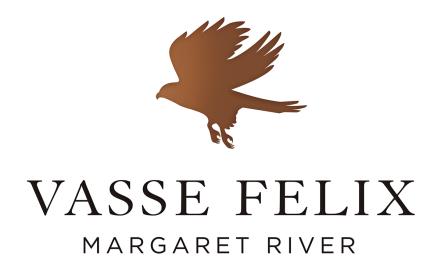Vasse Felix
Heytesbury Chardonnay
Vasse Felix
Heytesbury Chardonnay
A selection of the most unique and striking vineyard sections, recognised for its innovative winemaking and distinguishing 'Heytesbury' character.
Wine Production
Our most unique small vineyard sections where clone, aspect and soil interplay in such a way to ignite stunning varietal and wild yeast characters. A beautiful cool season saw Chardonnay picked three weeks later than the last 10 years, with elegant fruit perfumes, ideal sugar levels and high acidity. Malolactic fermentation was encouraged, though it is not an obvious feature of the wine. Due to the cool conditions, 52% of the fruit was Selectiv machine harvested to extract additional fine flavours from the skins before pressing. After settling for a short time, the cloudy juice was transferred straight to barrel. The remaining balance was hand-harvested, whole-bunch pressed and transferred direct to barrel as unclarified juice. The wine was fermented with only natural yeasts from the vineyard and remained in barrel for nine months with some battonage. The fruit was 100% Gingin clone from Wilyabrup and Wallcliffe.
Tasting Notes
Elegant, fragrant notes of hazelnut, mealy wafer and brioche intertwine with grapefruit, hints of fine lemon pith and honey dew melon. Underlying tones of candlewax, champignon, ginger and fennel also play a part in this complex perfume.
A satin light entrance builds to a long, tangy dry finish filled with delicate characters reminiscent of peach custard brioche, hazelnuts and candle wax, supported by fine lemon pith and anise
A selection of the most unique and striking vineyard sections, recognised for its innovative winemaking and distinguishing 'Heytesbury' character.
Wine Production
Our most unique small vineyard sections where clone, aspect and soil interplay in such a way to ignite stunning varietal and wild yeast characters. A beautiful cool season saw Chardonnay picked three weeks later than the last 10 years, with elegant fruit perfumes, ideal sugar levels and high acidity. Malolactic fermentation was encouraged, though it is not an obvious feature of the wine. Due to the cool conditions, 52% of the fruit was Selectiv machine harvested to extract additional fine flavours from the skins before pressing. After settling for a short time, the cloudy juice was transferred straight to barrel. The remaining balance was hand-harvested, whole-bunch pressed and transferred direct to barrel as unclarified juice. The wine was fermented with only natural yeasts from the vineyard and remained in barrel for nine months with some battonage. The fruit was 100% Gingin clone from Wilyabrup and Wallcliffe.
Tasting Notes
Elegant, fragrant notes of hazelnut, mealy wafer and brioche intertwine with grapefruit, hints of fine lemon pith and honey dew melon. Underlying tones of candlewax, champignon, ginger and fennel also play a part in this complex perfume.
A satin light entrance builds to a long, tangy dry finish filled with delicate characters reminiscent of peach custard brioche, hazelnuts and candle wax, supported by fine lemon pith and anise
Brand Materials
Vineyard & Production Info
Winemaking & Aging
Analytical Data
About the Vineyard
2017 was a cooler and later vintage than the previous 10 years; a year of elegant, perhaps slightly lighter bodied wines, though ripe in flavour, vibrant and very perfumed. Higher than average yields in combination with a cooler season contributed to delayed ripening of the fruit and good acid retention. With the cooler weather, canopy management and fruit thinning was imperative to mitigate disease pressures and allow for even, persistent ripening.






